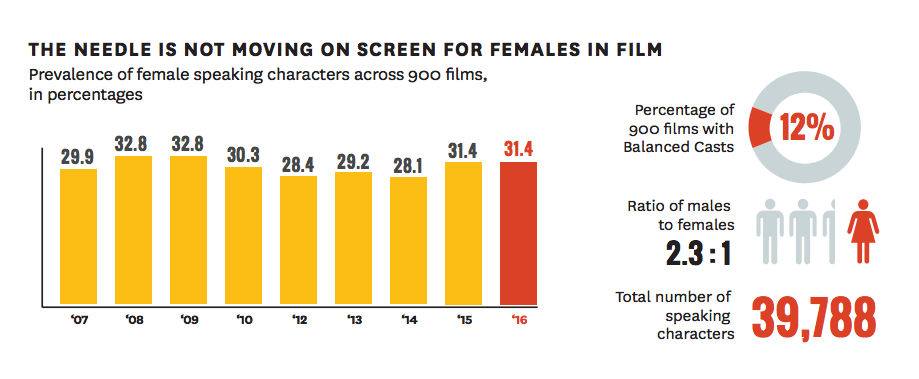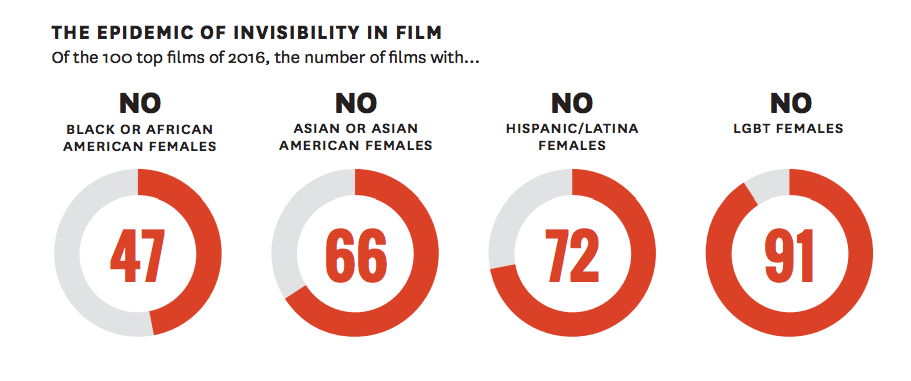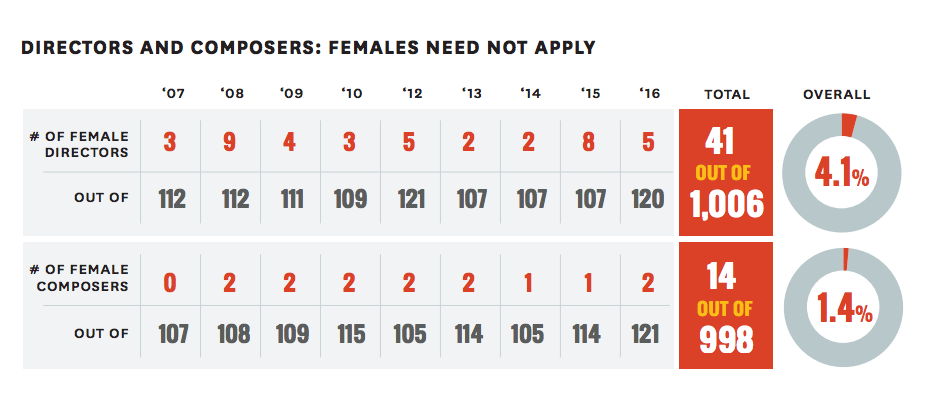
Conversations about more inclusivity and better representation in film have undoubtedly increased within the last decade; unfortunately, the actual numbers of women, minorities, LGBTQ individuals, and people living with disabilities on screen have not. That’s the conclusion USC Annenberg’s Media, Diversity & Social Change (MDSC) Initiative came to in their latest study, “Inequality in 900 Popular Films.”

Led by Dr. Stacy L. Smith, the report is an examination of the 900 highest-grossing films in the U.S. from 2007 to 2016 (with the exception of 2011) and their 39,788 characters, making it the largest study of its kind. The numbers suggest that the last 10 years have not been kind to characters that aren’t straight, able-bodied white men. And the demographics are even worse behind the camera.
Less than a third of the films’ speaking characters are female. Female characters of color are especially underrepresented: 47 films feature zero black women on screen, 66 include zero Asian women, and 72 feature zero Latina women. Further, there are no LGBTQ-identifying female characters in 91 of the movies the MDSC examined.

Overall, the number of LGBTQ, non-white, and disabled characters in top-grossing films have reached a plateau. In 2016’s top 100 films, non-white characters represent 29.2 percent of all roles, LGBTQ characters account for 1.1 percent of all speaking roles, and characters with disabilities make up 2.7 percent of all speaking roles. Those numbers have not changed since 2015.

Women are also being shut out of behind-the-camera roles. Of the 900 films examined, women account for just 1.4 percent of all composers. Just 4.1 percent of directors are female — and only five of them are non-white (3 black women and 2 Asian women).
“Popular movies paint a distressing portrait that perpetuates a version of
the U.S. that simply no longer exists,” the authors of “Inequality in 900 Popular Films” argue in the study’s conclusion. “By taking inclusion seriously and acting to address it, companies, consumers, and creators can ensure that entertainment moves away from a vision of the past and toward content that resembles the audience of the present.”
It can also be quite lucrative. Besides being a moral issue, inclusivity in film has proven to be a box office draw. In June Creative Artists Agency (CAA) published a study concluding that racially inclusive movies — whether they are blockbusters or indies — consistently earn more at the box office than their non-diverse counterparts. And the 2017 Diversity Report offered evidence that movies with diverse casts gross the highest median global box office and receive the highest media return on investment. We’ll say it again: inclusivity sells.
Check out some of the major findings from “Inequality in 900 Popular Films” below or read the full report here.
Of the 900 top films from 2007 to 2016 (excluding 2011) and their 39,788 characters:
- Less than one-third of speaking characters on screen were girls/women
- 47 films did not feature one Black or African American female
- 66 movies did not include on Asian or Asian American female
- 72 films did not depict one Hispanic/Latina female
- 91 movies had not one LGBT female
- Only 1.4% of composers were female
Of the top films of 2016:
- Just 31.4% of characters were female
- Characters from underrepresented racial/ethnic groups were 29.2% of all characters, which is not different from 2015
- LGBT-identified characters represented 1.1% of all speaking characters, which is not different from 2015
- Characters with disabilities filled only 2.7% of all speaking roles, which is not different from 2015
- “There has been little to no meaningful change in the representation of these diverse groups in popular movie content since 2015.”
Out of the 1,006 directors hired on the 900 films studied:
- Just 4.1% were female
- Only 5.6% of the directors were Black or African American
- A mere 3% were Asian or Asian American
- 3 Black or African-American women and 2 Asian women worked as directors







